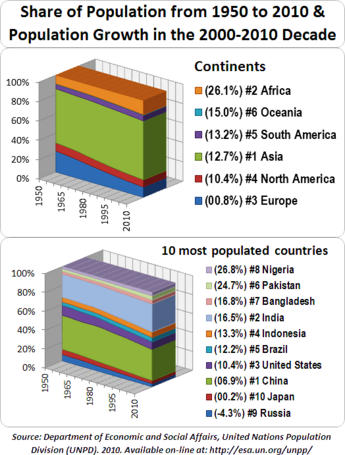
Asia accounts for over 60% of the world population with more than 4 billion people. China and India together have about 37 percent of the world's population. Africa follows with 1 billion people, 15% of the world's population. Europe's 733 million people make up 11% of the world's population. Latin America and the Caribbean region is home to 589 million (9%), Northern America is to 352 million (5%) and Oceania to 35 million (0.5 %).
Milestones by the billions
| Population
(in billions) | 1 | 2 | 3 | 4 | 5 | 6 | 7 | 8 | 9 | |||||||||
|---|---|---|---|---|---|---|---|---|---|---|---|---|---|---|---|---|---|---|
| Year | 1804 | 1927 | 1960 | 1974 | 1987 | 1999 | 2012 | 2027 | 2046 | |||||||||
| Years elapsed | - | 123 | 33 | 14 | 13 | 12 | 13 | 15 | 19 | |||||||||
It is estimated that the population of the world reached one billion in 1804, two billion in 1927, three billion in 1960, four billion in 1974, five billion in 1987, and six billion in 1999. It is projected to reach seven billion in October 2011, and around eight billion by 2025–2030. By 2045–2050, the world's population is currently projected to reach around nine billion, with alternative scenarios ranging from 7.4 billion to 10.6 billion. Projected figures vary depending on such things as the underlying assumptions and which variables are manipulated in projection calculations, especially the fertility variable. Such variations give long-range predictions to 2150, ranging from population decline to 3.2 billion in the 'low scenario', to high scenarios of 24.8 billion, or soaring to 256 billion assuming fertility remains at 1995 levels.
There is no estimation on the exact day or month the world's population surpassed both the one and two billion marks. The day of three and four billion were not officially noted, but the International Database of the United States Census Bureau places them in July 1959 and April 1974. The United Nations did determine, and celebrate, the "Day of 5 Billion" (11 July 1987), and the "Day of 6 Billion" (12 October 1999). The International Programs division of the United States Census Bureau estimated that the world reached six billion on 21 April 1999 (several months earlier than the official United Nations day). The "Day of 7 Billion" has been targeted by the United States Census Bureau to be in March 2012, while the Population Division of the United Nations suggests 31 October 2011.
Regional billion milestones
Regionally, the first region to hit a billion people was the Northern Hemisphere, followed shortly by the Eastern Hemisphere well before the world total hit two billion. Next in coming was Asia, then East Asia and South Asia, followed by China in 1980, India in 1999, Western Hemisphere in 2000s and Africa in 2010. The next billion people milestones expected by demographers are the Americas, with a current population of around 920 million, the Southern Hemisphere and Subsaharan Africa with each around 850 million people. It is not known if the current next contenders, Europe, Southeast Asia, and North America in that order, will ever surpass 1 billion people.
As for 2, 3, and 4 billion, only the Northern Hemisphere, Eastern Hemisphere, and Asia have surpassed these figures.
No comments:
Post a Comment